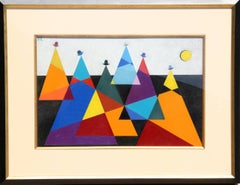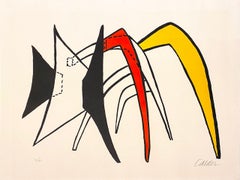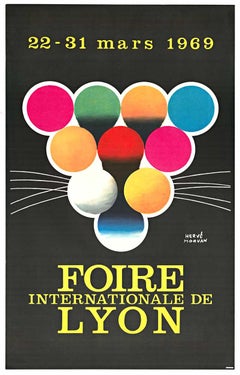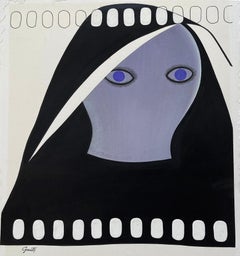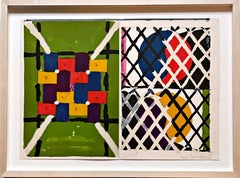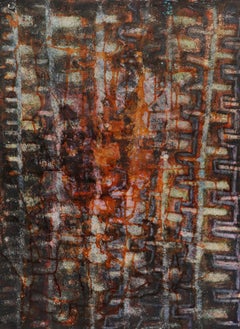Abstract Geometric Art
to
41
69
64
80
28
26
Overall Width
to
Overall Height
to
1
8
1,707
2,974
1
1
1
11
13
47
220
737
273
153
13,961
3,034
2,204
1,869
1,246
917
852
548
240
192
93
58
8
1
151
77
36
11
9
7
4
4
4
4
4
2
2
2
2
2
2
2
1
1
1
1
1
68
57
54
41
37
20
17
9
8
6
76
66
197
57
Period: 1960s
Period: 1950s
Style: Abstract Geometric
Women Walking, Abstract Painting on Paper by Omar Rayo
By Omar Rayo
Located in Long Island City, NY
An early painting by Omar Rayo from 1955. An abstract geometric work with multi-colored shapes on a surrealist horizon.
Artist: Omar Rayo, Colombian (1928 - )
Title: Mountains
Year:...
Category
1950s Abstract Geometric Art
Materials
Paper, Acrylic
'Stabiles'
Located in New York, NY
Alexander Calder’s ‘Stabiles’ lithograph captures the essence of his sculptural works known as "stabiles"—stationary counterparts to his mobiles—through a bold, abstract visual langu...
Category
1960s Abstract Geometric Art
Materials
Lithograph
Original "Foire Internationale de Lyon" vintage lithograph poster for sale
Located in Spokane, WA
Original “Foire Internationale de Lyon” vintage poster. Archival linen backed. In excellent condition A+, ready to frame. NO damage, no restoration, no fold marks. Full lithogr...
Category
1960s Abstract Geometric Art
Materials
Lithograph
The Last Snapshot - Minimalism
Located in Miami, FL
This graphic and flatwork was an Interior illustration for the Saturday Evening Post.
George Giusti( Italian - American 1908-1990)- ''The Last Snapshot''- ink and acrylic on illust...
Category
1960s Abstract Geometric Art
Materials
Ink, Acrylic, Gouache
Alfred Jensen, Deluxe VIP Hand Signed Edition #85/100, 1 Cent Life, '64, Framed
Located in New York, NY
Alfred Jensen
Untitled (Deluxe Artists & Collaborators Edition of the One Cent Life portfolio), 1964
Color lithograph on two pages wove paper (from the Artists & Collaborators hand s...
Category
1960s Abstract Geometric Art
Materials
Lithograph
Edward Marecak “Mystic Ladders” Mid-Century Abstract Mixed Media Painting
Located in Denver, CO
"Mystic Ladders" is an original mid-20th century abstract painting by noted Denver modernist Edward Marecak (1919–1993), a pivotal figure in Colorado’s postwar art movement. Executed...
Category
1960s Abstract Geometric Art
Materials
Pastel, Acrylic
Self-portrait - Lithograph (Mourlot)
By Raoul Dufy
Located in Paris, IDF
Raoul DUFY (1877-1953)
Self-portrait
Lithograph (Mourlot workshop)
Printed signature in the plate
On vellum 30 x 24 cm (c. 11.8 x 9.4 in)
INFORMATION : Lithograph created in tribu...
Category
1960s Abstract Geometric Art
Materials
Lithograph
Free Arrangements of Equal Parts Geometric Abstract Screenprint by Herbert Bayer
Located in Long Island City, NY
Free Arrangements of Equal Parts by Herbert Bayer, Austrian (1900–1985)
Date: circa 1968
Screenprint, signed and numbered in pencil
Edition of 12/75
Size: 29.75 x 29.5 in. (75.57 x 7...
Category
1960s Abstract Geometric Art
Materials
Screen
Sport : The Surrealist Archer - Original Lithograph (Mourlot)
By Jean Lurçat
Located in Paris, IDF
Jean LURCAT (1892-1966)
The Archer, 1965
Original lithograph (Mourlot workshop)
Printed signature in the plate
On vellum 30 x 24 cm (c. 11.8 x 9.4 in)
INFORMATION : Lithograph cre...
Category
1960s Abstract Geometric Art
Materials
Lithograph
Witches Entrance 1960s Abstract Geometric Composition, Figures in Red Green Blue
Located in Denver, CO
A dynamic and boldly imaginative work by celebrated mid-century Denver artist Edward Marecak, "Witches Entrance" is an original abstract painting dating to the 1960s. Rich in color a...
Category
1960s Abstract Geometric Art
Materials
Oil Pastel, Acrylic
Reihenbilder Spieltafeln (Geometric Abstraction, Minimalism, Constructivism)
By Klaus Basset
Located in Kansas City, MO
Klaus Basset
Reihenbilder Spieltafeln
Offset Lithograph
1967
23.62 x 16.53 inches (60 x 42 cm)
Unsigned as issued
COA provided
*Condition: Creasing along the edges. Folded. Otherwis...
Category
1960s Abstract Geometric Art
Materials
Lithograph, Offset
Clandestine Game, Abstract Geometric Screenprint by Omar Rayo
By Omar Rayo
Located in Long Island City, NY
An abstract geometric screenprint by Omar Rayo from 1966.
Artist: Omar Rayo, Colombian (1928 - 2010)
Title: Clandestine Game
Year: 1966
Medium: Screenprint, signed and numbered in ...
Category
1960s Abstract Geometric Art
Materials
Screen
Alfred Jensen, Duality Triumphant I, 1963 Signed/N, GE Art Collection, Framed
Located in New York, NY
Alfred Jensen
Duality Triumphant I (Mid Century Modern Geometric Abstraction), 1963
Color Silkscreen on wove paper
Pencil signed, dated, named and number 19/52 by Alfred Jensen on th...
Category
1960s Abstract Geometric Art
Materials
Screen
untitled 1 Minimalist Abstract Silkscreen 1969 by Michael Argov
Located in Long Island City, NY
Artist: Michael Argov, Austrian/Israeli (1920 - 1982)
Title: untitled 1
Year: 1969
Medium: Serigraph, signed and numbered in pencil
Edition: 32
Size: 27.5 x 20 inches (69.85 x 50.8 cm)
Category
1960s Abstract Geometric Art
Materials
Screen
Mid Century 1960's Original Colorful Abstract Woodblock Figurative Museum
Located in Buffalo, NY
An original Mid Century woodblock print titled "Long Hot Summer" by American artist Toma Yovanovich. Hand signed in pencil and numbered 2 ...
Category
1960s Abstract Geometric Art
Materials
Woodcut
'Darnaud Abstract' by Maxime Darnaud, Oil on Canvas
Located in Oklahoma City, OK
This 26" x 34.5" oil on canvas painting was done in 1958 by French Postwar & Contemporary artist, Maxime Darnaud. Darnaud was born in 1931 and died in 2015. This painting is a modern...
Category
1950s Abstract Geometric Art
Materials
Canvas, Oil
Original Cinquantenaire Aeronautique Bourget, vintage air show poster
Located in Spokane, WA
Original Cinquantenaire Aeronautique vintage poster. Archival linen backed and ready to frame. Printer: Bedos & Co, Paris. A- condition. (50TH ANNIVERSARY 23E SALON INTERNATIONAL D' AERONAUTICS, JUNE 12 TO 21, 1959 * LE BOURGET AIRPORT.)
This mid-century modern original French poster is for an air show...
Category
1950s Abstract Geometric Art
Materials
Lithograph
Still Life with Violin - Original Lithograph (Mourlot)
Located in Paris, IDF
Bernard BUFFET (1928-1999)
Still Life with Violin, 1965
Original lithograph (Mourlot workshop)
Printed signature in the plate
On vellum 30 x 24 cm (c. 11.8 x 9.4 in)
INFORMATION :...
Category
1960s Abstract Geometric Art
Materials
Lithograph
Pieces Collage, vibrant mid-century abstract expressionist black, pink & red
Located in Beachwood, OH
Richard Andres (American, 1927-2013)
Pieces Collage, c. 1965
collage on paper
14 x 18 inches
Richard Andres was born in Buffalo, New York in 1927. A graduate of the Cleveland Institute of Art in 1950, he was immediately drafted and served for two years in the army as a mural painter. He received his Master of Arts from Kent State in 1961. A frequent exhibitor at galleries and museums and winner of multiple May Show prizes, Andres taught art in the Cleveland Public Schools for 28 years, as well as teaching the University of Buffalo, the Cleveland Institute of Art and the Western Reserve University.
Very little in Richard Andres’ childhood would have predicted his love of classical music, mid-century-modern architecture and certainly not his lifelong passion for art and in particular abstract art. Richard’s father, Raymond, had no more than a third-grade education, and his mother, Clara, was one of thirteen children – only three of whom lived into adulthood and none of whom attended high school.
They lived, when Richard was a boy, in a dingy area of Buffalo, NY in a walk-up apartment situated above a tavern. Raymond and Clara supplemented the income from their factory jobs in the bar downstairs with Raymond playing ragtime on the piano and Clara serving drinks. This often left Richard and his two older brothers at home alone to fend for themselves. The two older boys, Raymond and Russell, were - unlike Richard- rather rough and tumble and entertained themselves with stickball, boxing and the like. Richard, on the other hand, from a very young age liked to draw, or better yet even, to paint with the small set of watercolors he received for Christmas one year. Paper, however, at the height of the depression, was hard to come by. Luckily, Clara used paper doilies as decoration for the apartment and Richard would contentedly paint and then cut up doilies, gluing the pieces together to create collages.
At eight-years-old, he discovered the Albright-Knox Museum (then known as the Albright Art Gallery) and spent several hours a week there studying the paintings. He was particularly fond of Charles Burchfield‘s landscapes, enamored with their ‘messiness’ and thinking that they somehow captured more ‘feeling’ than works he was previously familiar with. For his tenth Christmas, he asked for and received a ‘how-to’ paint book by Elliot O’Hare. Through this self-teaching, he assembled the portfolio needed for acceptance to Buffalo Technical High School where he studied Advertising Arts. In his Junior year, he was encouraged to enter a watercolor painting, “Two Barns,” in the national 1944-45 Ingersoll Art Award Contest and was one of twelve grand prize winners – each one winning one hundred dollars. More importantly the painting was exhibited at the Carnegie Institute Galleries, which resulted in his winning a national scholarship to the Cleveland School of Art (The Cleveland Art Institute).
He flourished at the art school under the tutelage of faculty members such as Carl Gaertner, as well as that of visiting artists such as William Sommer and Henry George Keller. He would say in later years that Gaertner, in particular, influenced his attitude toward life as well as art. “Gaertner,” Andres said, “believed that there was no need to be a ‘tortured artist’, that an artist should rather enjoy beauty, family, and life in general.” Free to spend his days as he chose, he wandered the Cleveland Art Museum for most of the hours he was not attending classes or painting; the remaining time was spent drinking coffee at a local hangout with art school friends – which is where he met fellow Henry Keller scholarship winner, Avis Johnson. Richard was immediately smitten with Avis, but being rather shy, it took him the entire summer of 1948 to build up his courage to ask her out. Over that summer he ‘thought about Avis’ and worked in a diner to save money. He also used the hundred-dollar prize money won in High School to visit the first Max Beckmann retrospective in the United States at the City Art Museum in St. Louis. Over a half century later he spoke of that exhibit with a reverence usually reserved for spiritual matters, “I walked in and it was like nothing I had ever seen before... the color...It just glowed.”
Returning to campus in the Fall, the first thing he did was go to the coffee shop in hopes of finding Avis. He did, and she, upon seeing him, realized that she was also smitten with him. They quickly became known as ‘the couple’ on campus, and a year later, with Richard being drafted for the Korean war, they were quickly married by a Justice of the Peace, celebrating after with family at Avis’s Cleveland home. As a gift, faculty member John Paul Miller designed and made the simple gold wedding ring Avis wore for their 65 years of marriage. During those 65 years neither wavered in their mutual love, nor in the respect they shared for one another’s art.
The couple lived in a converted chicken coop in Missouri while Richard was in boot camp. At the camp, he would volunteer for any job offered and one of those jobs ended up being painting road signs. His commander noticed how quickly and neatly he worked and gave him more painting work to do - eventually recommending him for a position painting murals for Army offices in Panama. Until her dying day, Avis remained angry that “The army got to keep those fabulous murals and they probably didn’t even know how wonderful they were.” In Panama, their first son, Mark, was born. After Richard’s discharge in 1953, they moved back to the Cleveland area and used the GI bill to attend Kent State gaining his BA in education. The small family then moved briefly to Buffalo, where Richard taught at the Albright Art School and the University of Buffalo – and their second son, Peter, was born. Richard had exhibited work in the Cleveland May Show and the Butler Art Museum during his art school years, and during the years in Buffalo, his work was exhibited at the gallery he had so loved as a child, the Albright Art Gallery.
In 1956, the family moved back to the Cleveland area and Richard began teaching art at Lincoln West High School during the day while working toward his MA in art at Kent State in the evenings. Avis and Richard, with the help of an architect, designed their first home - a saltbox style house in Hudson, Ohio, and in 1958, their third son, Max (after Max Beckmann) was born. Richard enjoyed the consistency of teaching high school as well as the time it gave him to paint on the weekends and during the summer months. In 1961, he received his MA and his daughter, Claire, was born. With a fourth child, the house was much too small, and Avis and Richard began designing their second home. An admirer of MCM architecture, Richard’s favorite example of the style was the Farnsworth house – he often spoke of how the concepts behind this architectural style, particularly that of Mies van der Rohe, influenced his painting.
Andres described himself as a 1950’s...
Category
1960s Abstract Geometric Art
Materials
Acrylic
Music : The Cellist - Original Lithograph (Mourlot)
Located in Paris, IDF
Jacques VILLON (1875-1963)
The Cellist, 1965
Original lithograph (Mourlot workshop)
Printed signature in the plate
On vellum 30 x 24 cm (c. 11.8 x 9.4 in)
INFORMATION : Lithograph...
Category
1960s Abstract Geometric Art
Materials
Lithograph
Concentric Squares painting, Mid Century Geometric Abstraction, Signed, Framed
By Josef Zenk
Located in New York, NY
Josef Zenk
Untitled Concentric Squares (Mid Century Modern Geometric Abstraction), ca. 1960
Oil on canvas painting
Boldly signed by Josef Zenk on the lower right front
Frame included...
Category
1960s Abstract Geometric Art
Materials
Canvas, Oil
Original 'Secret Ceremony' or "Ceremonie Secrete" vintage movie poster
Located in Spokane, WA
Original linen-backed Secret Ceremony vintage film poster. French, archival linen backed in fine condition, ready to frame.
A woman and the girl s...
Category
1960s Abstract Geometric Art
Materials
Offset
Original Pamplona Running of the Bulls vintage poster San Fermin, Spain
Located in Spokane, WA
Original San Fermin Pamplona running of the bulls, vintage poster.
Archival linen backed in very fine condition ready to frame. Artist: Alonso Astarloa....
Category
1960s Abstract Geometric Art
Materials
Lithograph
$1,000 Sale Price
20% Off
Embossed Linear Constructions (ELC) 2-C, 1969
By Josef Albers
Located in Columbia, MO
Edition 38/100
Josef Albers (b.1888, Germany ) built legacies as an artist, designer, and teacher, and may be familiar to any former student of art or design (even if for only one, ...
Category
1960s Abstract Geometric Art
Materials
Archival Paper
Dial Set One, Geometric Abstract Screenprint by Gordon House
By Gordon House
Located in Long Island City, NY
This screenprint was created by Welsh artist Gordon House (1932-2004). House was a designer and painter whose hard-edged abstract works reflected the dramatic tensions of his graphic...
Category
1960s Abstract Geometric Art
Materials
Screen
$960 Sale Price
20% Off
Embossed Linear Constructions (ELC) 1-D, 1969
By Josef Albers
Located in Columbia, MO
Edition 38/100
Josef Albers (b.1888, Germany ) built legacies as an artist, designer, and teacher, and may be familiar to any former student of art or design (even if for only one, ...
Category
1960s Abstract Geometric Art
Materials
Archival Paper
Mid Century Modern 1960s Abstract Geometric Collage w Navy Blue, Green & Purple
Located in Soquel, CA
Dynamic late 1960's mixed media abstract geometric collage, with mulberry paper cut into curved and angular shapes and adhered in layers, in a unique color palette of navy blue, dark...
Category
1960s Abstract Geometric Art
Materials
Mulberry Paper, Tissue Paper
Ross Bleckner Geometric Abstract Painting, 1960s
Located in New York, NY
Ross Bleckner (American, b. 1949)
Untitled (Geometric Abstraction)
Acrylic on board
19 1/2 x 16 3/4 in.
Signed lower right: Ross '66
Ross Bleckner grew up in Hewlett, Long Island, N...
Category
1960s Abstract Geometric Art
Materials
Acrylic, Board
Original Arabic Art - Spain vintage travel poster
By José Ortega
Located in Spokane, WA
Original Arabic Art – Spain vintage travel poster. Artist: Jose Ortega. Size: 24.5" x 39.5". C. 1950. Original vintage European travel poster...
Category
1950s Abstract Geometric Art
Materials
Lithograph
$620 Sale Price
20% Off
Musee National d'Art Moderne (after) Wassily Kandinsky - Abstract
Located in New York, NY
This rare lithographic poster was printed in 1957 at the Atelier Mourlot in Paris. It was created to promote an exhibition of artworks by Kandinsky, on loan from the Guggenheim Museu...
Category
1950s Abstract Geometric Art
Materials
Lithograph
Lynn Leland, unique geometric abstraction Op Art painting, Albright Knox Gallery
Located in New York, NY
Lynn Leland
Untitled Op Art painting, 1967-1968
Acrylic on Canvas (with Albright Knox Gallery Label, A. M Sachs Gallery Label, Atlantic Richfield Corporate Art Collection label and A...
Category
1960s Abstract Geometric Art
Materials
Acrylic
Mid Century Modern Geometric Abstract Print "indian Trails"
Located in Buffalo, NY
Mid-Century Modern geometric abstract print by American artist Toma Tovanovich (1931- 2016). Tovanovich's work is found in many public and p...
Category
1960s Abstract Geometric Art
Materials
Color
Untitled Mid-Century Modern Geometric Abstraction
Located in New York, NY
Arnaldo Pomodoro
Untitled Mid-Century Modern Geometric Abstraction, 1968
Silkscreen with colors on rag paper with deckled edges
Hand signed, numbered 44 from the edition of 80 and da...
Category
1960s Abstract Geometric Art
Materials
Rag Paper, Screen
Original Basel (Switzerland) vintage travel poster fastnacht
Located in Spokane, WA
Original vintage poster: BASEL (Switzerland).
In ancient Basel, they beat the drums at night to drive the evil demons from the city. Fastnacht. Museum linen backed. Basel; the city on the Rhein and much more! Printer and illustator: Schaffner.
This image features the drum that you beat all night long to drive the bad spirits from the city. A drama mask...
Category
1960s Abstract Geometric Art
Materials
Lithograph
$380 Sale Price
20% Off
Rheinisches Landesmuseum Bonn (Shrine) Poster /// Josef Albers Abstract Bauhaus
By Josef Albers
Located in Saint Augustine, FL
Artist: (after) Josef Albers (German-American, 1888-1976)
Title: "Rheinisches Landesmuseum Bonn (Shrine)"
Year: 1968
Medium: Original Relief Print (Letterpress), Exhibition Poster on...
Category
1960s Abstract Geometric Art
Materials
Paper
Iron Butterfly, Geometric Abstract Screenprint with Silver Detail by Krushenick
Located in Long Island City, NY
Artist: Nicholas Krushenick
Title: Untitled from the Iron Butterfly Suite
Year: 1968
Medium: Screenprint, signed and dated in pencil, verso
Edition: 125 (unnumbered)
Paper Size: 35.5...
Category
1960s Abstract Geometric Art
Materials
Screen
Tage Slawischer Kulture
Located in Spokane, WA
Original poster: Linen-backed original poster "Tage Slawischer Kultur" done by the artist Rasch. The days of Slavic Culture. This would cover the countries knowns as Slavic language speaking people: Russia, the Ukraine, Belarus, Poland, Czech Republic, Slovakia, Bulgaria, Slovenia, Croatia, Serbia, Bosnia and Herzegovina, Macedona and Montenegro.
A drama mask in white rests on a leaning abstract color panel that could be a scarf or material that blends the styles and colors inlocking together to form a cultural pattern. A dark blue background brings the image to the forefront of this vintage original poster.
Every year on May 24th all Slavic countries commemorate Saints Cyril...
Category
1960s Abstract Geometric Art
Materials
Screen
$340 Sale Price
20% Off
Welded Brushed Steel Sculpture - geometric abstraction (Unique, signed)
By Michael Todd
Located in New York, NY
Michael Todd
Welded Brushed Steel Sculpture - geometric abstraction, 1968
Welded Brushed Steel
Hand signed and dated 1968 in marker on surface....
Category
1960s Abstract Geometric Art
Materials
Steel
Damier, from Derriere Le Miroir #156
Located in Washington, DC
Artist: Alexander Calder
Medium: Original lithograph
Title: Damier
Portfolio: Derriere le Miroir #156
Year: 1966
Edition: Unnumbered
Framed Size: 21 1/4" x 17 1/4"
Sheet Size: 15" x...
Category
1960s Abstract Geometric Art
Materials
Lithograph
French Avant Garde Bold Abstract Geometric Aquatint Etching Op Art Kinetic
Located in Surfside, FL
Original etching, aquaforte, aquatint engraving. poetry text by Robert Pinget on facing fold of sheet. The individual sheet is unsigned. The justification page is hand signed by th...
Category
1960s Abstract Geometric Art
Materials
Etching, Aquatint
Variant III /// Bauhaus Abstract Geometric Minimalism Josef Albers Screenprint
By Josef Albers
Located in Saint Augustine, FL
Artist: Josef Albers (German-American, 1888-1976)
Title: "Variant III"
Portfolio: Ten Variants
*Unsigned edition
Year: 1967
Medium: Original Screenprint on Rives BFK paper
Limited ed...
Category
1960s Abstract Geometric Art
Materials
Screen
The Cat's Pajamas
By Frank Roth
Located in Long Island City, NY
Artist: Frank Roth, American (1936 - )
Title: The Cat's Pajamas
Year: 1968
Medium: Oil on Canvas, signed, titled and dated verso
Size: 66 x 72 in. (167.64 x 182.88 cm)
Category
1960s Abstract Geometric Art
Materials
Oil
1960s Swiss Postwar Contemporary Geometric Abstract Painting on Metal Jean Baier
By Jean Baier
Located in Surfside, FL
Jean Baier (Swiss, 1932-1999)
"Composition"
1960
An original enamel composition on metal wall mount art. This post war contemporary work features geometric abstract designs character...
Category
1960s Abstract Geometric Art
Materials
Metal
Colorful Geometric Abstract Screen Print by Joseph Grippi
Located in Long Island City, NY
Joseph Grippi, American (1924 - 2001) - Colored Circles, Year: 1968, Medium: Screenprint, signed and numbered in pencil, Edition: 8/35, Image Size: 24 x 18 inches, Size: 28 x 20.25 i...
Category
1960s Abstract Geometric Art
Materials
Screen
'Roofs of Ravello', Mid-Century Abstract, Harvard Fogg Museum, SFAA, Carmel, AIC
Located in Santa Cruz, CA
'Roofs of Ravello' by Margaret Wentworth, 1959.
Mid-Century Abstract, Harvard Fogg Museum, San Francisco Art Association, Carmel, Art Institute of Chicago
------
Initialed lower rig...
Category
1950s Abstract Geometric Art
Materials
Pen, Postcard, Egg Tempera
Abstract Composition - Lithograph by Kumi Sugai - 1960
Located in Roma, IT
Abstract Composition is a color lithograph realized by the Japanese artist Kumi Sugai in 1960.
Good conditions except for slight cutting and folding on the margins.
Kumi Sugai (1919-1996) was a Japanese painter...
Category
1960s Abstract Geometric Art
Materials
Lithograph
Red Cube, Abstract Geometric Screenprint by Gerald Marks
Located in Long Island City, NY
Gerald Marks, British (1921 - 2018) - Red Cube, Year: 1968, Medium: Screenprint on thick paper, signed, numbered and dated in pen, Edition: 6/35, Size: 16...
Category
1960s Abstract Geometric Art
Materials
Screen
Colorful Geometric Abstract Screen Print by Robert Tucker
Located in Long Island City, NY
Geometric Tablet by Robert Tucker, American
Date: circa 1970
Screenprint, signed and numbered in pencil
Edition of 12/200
Image Size: 24 x 23.75 inches
S...
Category
1960s Abstract Geometric Art
Materials
Screen
French Avant Garde Bold Abstract Geometric Aquatint Etching Op Art Kinetic
Located in Surfside, FL
Original etching, aquaforte, aquatint engraving. poetry text by Robert Pinget on facing fold of sheet. The individual sheet is unsigned. The justification page is hand signed by t...
Category
1960s Abstract Geometric Art
Materials
Etching, Aquatint
Sven Lukin Modernist Original Screenprint Framed 1969 Bright Modern Mid Century
By Sven Lukin
Located in Buffalo, NY
This incredible work comes with a COA.
The work is currently framed in a new acid free mat and the original 1969 silver metal frame, but new framing is available included in the pric...
Category
1960s Abstract Geometric Art
Materials
Silver
French Avant Garde Bold Abstract Geometric Aquatint Etching Op Art Kinetic
Located in Surfside, FL
Original etching, aquaforte, aquatint engraving. poetry text by Robert Pinget on facing fold of sheet. The individual sheet is unsigned. The justification page is hand signed by th...
Category
1960s Abstract Geometric Art
Materials
Etching, Aquatint
Olympia Fragment (LaFranca 9), Minimalist Etching by Ben Nicholson
Located in Long Island City, NY
Artist: Ben Nicholson, British (1894 - 1982)
Title: Olympia Fragment (LaFranca 9)
Year: 1965
Medium: Etching, signed and numbered in pencil
Image: 8 x 9.5 inches
Paper Size: 12.5 x ...
Category
1960s Abstract Geometric Art
Materials
Etching
Sven Lukin Modernist Original Screenprint Framed 1969 Bright Modern Mid Century
By Sven Lukin
Located in Buffalo, NY
This incredible work comes with a COA.
The work is currently framed in a new acid free mat and the original 1969 silver metal frame, but new framing is available included in the pric...
Category
1960s Abstract Geometric Art
Materials
Silver
untitled 4 Minimalist Abstract Silkscreen 1969 by Michael Argov
Located in Long Island City, NY
Artist: Michael Argov, Austrian/Israeli (1920 - 1982)
Title: untitled 4
Year: 1970
Medium: Serigraph, signed and numbered in pencil
Edition: 46
Size: 20 in. x 27.5 in. (50.8 cm x 69...
Category
1960s Abstract Geometric Art
Materials
Screen
Untitled (pour XXe Siecle)
Located in Fairlawn, OH
Linocut, printed on yellow wove paper
Unsigned as is usual
From: XXe Siecle, Volume 13, 1959
Published by G. San Lazzaro for A. Maeght, Paris
Printed by...
Category
1950s Abstract Geometric Art
Materials
Linocut
Vintage Mid-Century Modernist Cityscape Oil Painting - Geometric Neighbourhood
Located in Bristol, GB
GEOMETRIC NEIGHBOURHOOD
Size: 40 x 72.5 cm (including frame)
Oil on Canvas
A playful and brilliantly executed mid-century composition of a neighbourhood, painted in oil onto canvas ...
Category
1960s Abstract Geometric Art
Materials
Canvas, Oil
Stripes, Watercolor by Kenneth Noland circa 1965
Located in Long Island City, NY
Artist: Kenneth Noland, American (1924 - 2010)
Title: Stripes
Year: circa 1965
Medium: Watercolor
Size: 4.5 in. x 6.75 in. (11.43 cm x 17.15 cm)
Frame Size: 11.5 x 13.5 inches
Category
1960s Abstract Geometric Art
Materials
Watercolor
Abstract American Geometric Oil Painting Martin Rosenthal 60 Mid Century Modern
Located in Buffalo, NY
An original abstract oil painting by American artist Martin Rosenthal signed by the artist and created in the late 1950's, early 1960's.
This colorful dynamic work comes housed in a...
Category
1960s Abstract Geometric Art
Materials
Paper, Oil
Signed Geometric Abstract Screenprint on Foil Paper by Jean Baier
By Jean Baier
Located in Long Island City, NY
Artist: Jean Baier, Swiss (1932 - )
Title: Untitled - I
Tear: Circa 1968
Medium: Screenprint on Foil Paper, Signed in Ink
Edition: Epreuve d'Artiste
Size: 23 in. x 33 in. (58.42 cm ...
Category
1960s Abstract Geometric Art
Materials
Screen
Josef Albers: 25 Years of Graphic Work (Midnight and Noon VII) Poster /// Square
By Josef Albers
Located in Saint Augustine, FL
Artist: (after) Josef Albers (German-American, 1888-1976)
Title: "Josef Albers: 25 Years of Graphic Work (Midnight and Noon VII)"
Year: 1968
Medium: Original Lithograph, Exhibition P...
Category
1960s Abstract Geometric Art
Materials
Lithograph
Abstract Geometric art for sale on 1stDibs.
Find a wide variety of authentic Abstract Geometric art available for sale on 1stDibs. Works in this style were very popular during the 21st Century and Contemporary, but contemporary artists have continued to produce works inspired by this movement. If you’re looking to add art created in this style to introduce contrast in an otherwise neutral space in your home, the works available on 1stDibs include elements of blue, purple, orange, red and other colors. Many Pop art paintings were created by popular artists on 1stDibs, including Mitchell Funk, Josef Albers, Mauro Oliveira, and Claudia Fauth. Frequently made by artists working with Paint, and Synthetic Resin Paint and other materials, all of these pieces for sale are unique and have attracted attention over the years. Not every interior allows for large Abstract Geometric art, so small editions measuring 0.04 inches across are also available.
Recently Viewed
View AllMore Ways To Browse
Maggie Siner
Maplethorpe Calla
Marble Woman Head
Marcel Leprin
Mark Stock
Martin Hardie
Mauritz Lindstrom
Maximillien Luce
Michael Budden Central Park
Midcentury Matador Paintings
Mike Wright
Miracle On Ice
Mississippi River Painting
Monarch Of The Glen Painting
Moroccan Paintings Essaouira
Morpho Butterfly Art
Mount Tamalpais
Murray Dessner
